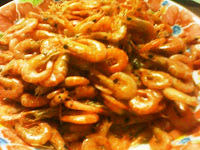"Not Like Any Other Tambis"
 My father's almost always excited about his harvest from our little fruit and vegetable garden. Whether it's just a papaya, three hanging potatoes, five tomatoes, or a small tray of calamansi, he would proudly tell us how his little garden has produced enough for our household needs. You would constantly see him bringing in varieties of fruits and vegetables, and planting them in our yard.
My father's almost always excited about his harvest from our little fruit and vegetable garden. Whether it's just a papaya, three hanging potatoes, five tomatoes, or a small tray of calamansi, he would proudly tell us how his little garden has produced enough for our household needs. You would constantly see him bringing in varieties of fruits and vegetables, and planting them in our yard. Another fruit tree added to our yard a few years back is the tambis. For the rest of us at home, waiting for it to bear fruits wasn't much of a thrill because we knew how the fruits tasted. They used to be abundant in the farm we have left. Still, he would insist that this one is of a "different kind" -- it would bear sweeter, crispier, and more succulent fruits--different from the ones we used to munch on during summer as kids.
Tambis (Syzygium aqueum, Family Myrtaceae) is a small, bell-shaped fruit which can grow to approximately three centimeters wide. It is known as a water apple because it is a watery fruit. The storage of water gives the plant a more swollen or fleshy appearance. It has waxy skin which comes in pink, white, and green. After biting through its skin, your teeth will sink into its spongy, white and juicy pulp. It is also known as watery rose apple but in the Visayas, it is called tambis. It is commonly found all over the country and also cultivated in India, southeastern Asia, and Indonesia.
The tree usually explodes with fruits towards summer. But having them all-year round is not surprising. Although it reaches its peak during the hot and dry season, the tambis tree bears fruits almost every month. At least that's what we can attest to with this tree that Papa has grown in our yard.
























.JPG)